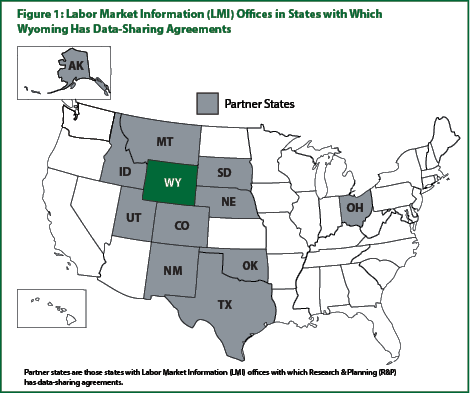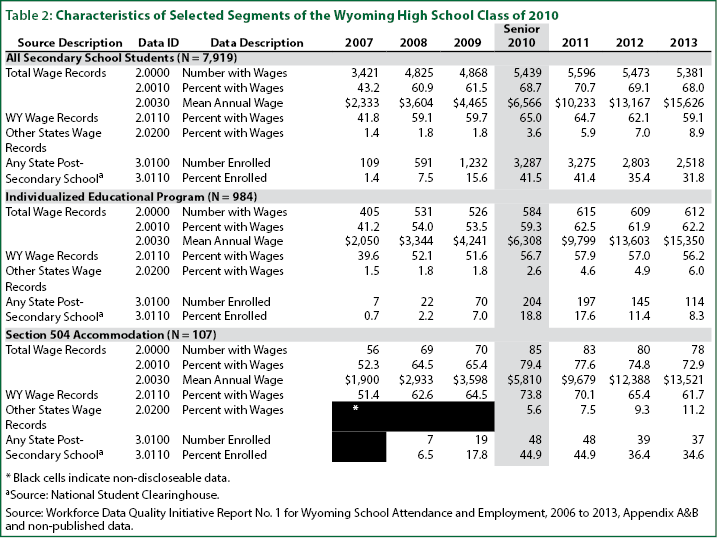WE Connect: Employment, Earnings, and Postsecondary Enrollment of Wyoming High School Students
Part 3: Graduation and Work Experience for Students with Special Needs
Excerpted from Workforce Data Quality Initiative Report No. 1 for Wyoming: School Attendance and Employment, 2006 to 2013: Chapter 1.
Editor’s note: In the interest of full disclosure, the author of this report is also a member of the Wyoming Governor’s Council on Developmental Disabilities.
In the 2009/10 school year, 13,173 Wyoming public school students, or 14.8% of the total, were classified as “children with disabilities” by the U.S. Department of Education, which includes those students who had an Individualized Education Program (IEP) or a 504 Vocational Rehabilitation Accommodation Plan (504 plan). The majority of the students classified in this manner by the U.S. Department of Education had an IEP. Because students with disabilities comprise a significant portion of the student population, and because labor market participation for adults with disabilities is significantly lower than the rest of the population, this publication focuses on the completion rate and labor market participation rate for high school students with an IEP or 504 plan.
According to the U.S. Bureau of Labor Statistics, in 2014, 17.1% of persons with a disability were employed, compared to 64.6% of the population without a disability1. The unemployment rate for persons with a disability was 12.5% in 2014, more than double the rate for persons without a disability (5.9%).
Prior to the Workforce Data Quality Initiative Grant, the labor force involvement for Wyoming public school students with an IEP or 504 plan was not available. The ability to identify where students work, what they earn, and their participation in the labor market during (and after) the high school years is critical to setting program goals and improving employment opportunities for those with a disability. Knowing the distribution of labor market participation gives educators and policymakers empirical evidence on which to base workforce and education policy decisions. In addition, the Research & Planning (R&P) section of the Wyoming Department of Workforce Services has data-sharing agreements with 11 other states (see Figure 1) and is in a unique position to describe labor market outcomes for Wyoming high school students. Therefore, it is prudent to examine participation in the labor market, earnings, and 12th grade completion rates for students with either IEPs or 504 plans in Wyoming public schools. In addition to developing the tools whereby labor market information is available, R&P examines the high school enrollment rates and labor market participation rates for students with an IEP or a 504 accommodation as one measure of the effectiveness of school-based early intervention programs for students with a documented disability. While research is clear that early intervention programs positively affect student readiness, little has been written about the availability of early intervention services in rural states like Wyoming.
Because Wyoming is a rural state and access to early intervention services may be severely limited due to the geographic location of the family in need and the location of qualified service providers, the distribution of public school staff with early intervention service credentials (e.g., speech and language pathologists, occupational therapists, etc.) warrants examination. Understanding the staffing patterns of Wyoming public schools and the distribution of early-intervention service providers in the state is key in order to facilitate the effective delivery of programs and services which can impact the completion rate and labor market participation rate for individuals with disabilities. One example of improved service delivery might be helping the state’s vocational rehabilitation agency identify students who are eligible for 504 programs at a younger age, so that students who would benefit from the program may have the opportunity to access vocational rehabilitation services before high school graduation. Understanding which school districts have access to licensed service providers and an adequate number and type of service providers is also necessary to ensure that early intervention needs are met for all Wyoming students who would benefit from such an intervention.
Given the challenges of a historically high unemployment rate for those with a disability, and the lack of longitudinal studies on the effect of pre-kindergarten early intervention programs in Wyoming schools, this publication focuses on a sub-population of the Class of 2010 – those with IEPs or 504 plans – and compares high school completion rates and labor market participation rates to the rest of the Class of 2010.
Of the Class of 2010, 984 students (12.4%) had an IEP at some point in their academic career. Of the 7,919 students in the Class of 2010, 30.8% (2,438) did not graduate high school that year (see Table 1). Of the 984 students with an IEP from the Class of 2010, 433, or 44.0%, did not graduate high school in 2010. Of the 107 students from the Class of 2010 with a 504 plan, 27 (25.2%) did not graduate their senior year of high school.
For the Class of 2010, 584 students with an IEP (59.3%) were found working in Wyoming or a partner state in 2010, compared with 68.6% of the general education population (see Table 2). Based on Unemployment Insurance (UI) wage records, 56.7% of students with IEPs had earnings in Wyoming in 2010, compared to 65.0% of all students from the Class of 2010. An additional 26 students with an IEP (2.6%) had earnings in other states based on wage records, compared to 3.6% for the total Class of 2010.
As shown in Figure 2, in 2010, students with an IEP or 504 plan working in Wyoming earned slightly less than the mean annual wage for all students from the Class of 2010. The mean annual wage for students from the Class of 2010 working in Wyoming was $6,566. The average earnings for those with an IEP for the same year were $6,308, while the average earnings for students with a 504 plan were lower, at $5,810.
While directions for future research are broad, the statistical application of WDE student data and administrative records offers tools to interested parties and service providers to improve the planning and delivery of services to the student population with special needs. In addition, the data in this report offer those with oversight responsibility for early intervention and special education delivery – such as Head Start, Child Development Services of Wyoming, the Wyoming Department of Education, school boards, the Wyoming State Legislature, and the Wyoming Governor’s Council on Developmental Disabilities – with an additional empirical and effective tool to carry out their duties.
The complete report from which this publication is extracted can be found at http://doe.state.wy.us/LMI/education_we_connect/WDQI_Pub1.pdf.
1U.S. Bureau of Labor Statistics. (2015). Persons with a Disability: Labor Force Characteristics Summary. Retrieved August 19, 2015, from http://www.bls.gov/news.release/disabl.nr0.htm




